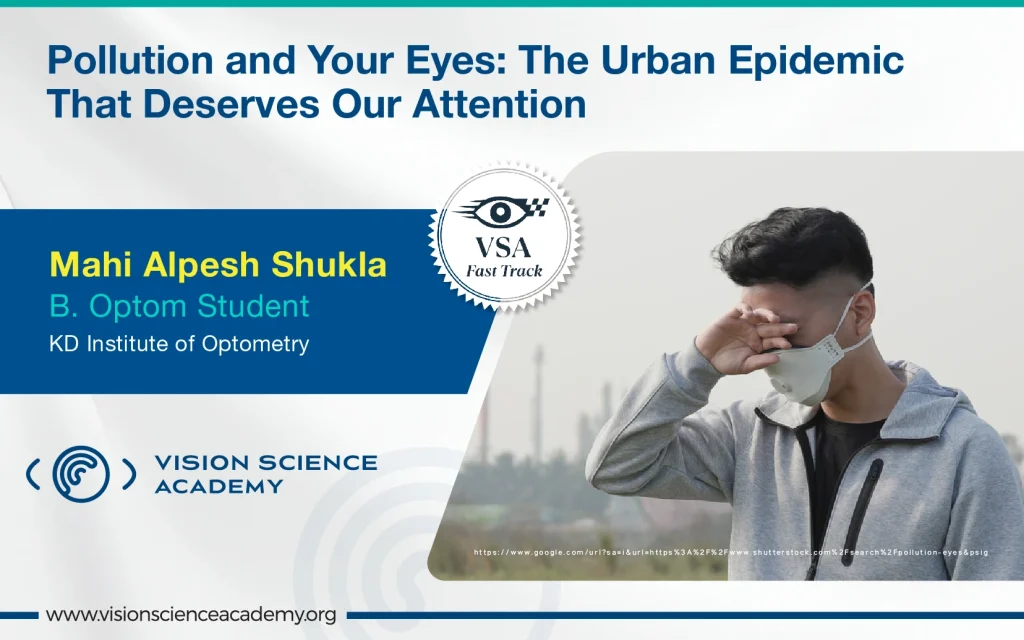Mahi Alpesh Shukla,
B. Optom Student, KD Institute of Optometry, Ahmedabad, India
Air pollution is a poisonous mix of gases and particulates, including Ozone (O₃), Nitrogen Oxides (NOx), Carbon Monoxide (CO), Sulphur Dioxide (SO₂), Volatile Organic Compounds (VOCs), and Fine Particulate Matter (PM2.5 and PM10), that negatively impact human health. While the respiratory and cardiovascular systems have received a lot of attention, the ocular system has long been overlooked, despite overwhelming evidence that pollution poses a major threat to eye health. (1,2) The eye is directly exposed to the environment and lacks the protective layer that protects inside organs. Furthermore, the retina and optic nerve are extensions of the central nervous system, rendering them extremely sensitive to the neurotoxic and oxidative effects of airborne contaminants. (1)
Beyond Irritation: Chronic Ocular Disorders
Although many people identify air pollution with short-term sensations like burning, redness, or tears, it is now clear that pollutants can cause persistent and progressive eye problems. According to epidemiological data, air pollution is strongly associated with illnesses such as allergic conjunctivitis, Dry Eye Syndrome, Glaucoma, Cataract, and Age-related Macular Degeneration (AMD). (2) Outdoor pollutants from both car emissions and indoor sources such as cooking fumes, tobacco smoke, and poor ventilation have been linked to ocular morbidity, particularly in urban areas where pollutant levels frequently exceed WHO safety guidelines.
Figure 1: Air pollution effects on our eyes via AIIMS survey
Pollution and Glaucoma: A Structural Insight
Large-scale population statistics have demonstrated a link between particulate matter (PM2.5) and glaucomatous alterations in the eye. In a study of over 111,000 people, those who lived in high-PM2.5 locations had a substantially higher incidence of self-reported glaucoma. Even more persuasive was the thinning of the macular ganglion cell-inner plexiform layer (GCIPL), as seen by OCT imaging, despite no change in intraocular pressure. (3) This suggests that pollution may act through non-pressure-dependent pathways, such as vascular impairment or direct neurotoxicity, contradicting the conventional concept of glaucoma development.
Experimental Proof: The Role of Oxidative Stress
Animal research has strengthened the relationship between air pollution and eye impairment. In one study, animals exposed to high PM10 levels showed heightened oxidative stress markers (increased malondialdehyde), depleted antioxidant levels (glutathione), corneal thinning, and decreased Nrf2 signalling, which is essential for cellular defence. (4) Surprisingly, therapy with SKQ1, a mitochondrial antioxidant, significantly corrected these degenerative alterations in both in-vivo (mouse cornea) and in-vitro (ocular cell culture). These findings indicate oxidative stress as a key mechanism and suggest possible treatment targets for pollution-induced ocular disorders.
Conclusion
Air pollution is no longer solely a respiratory or cardiovascular issue. Its widespread effect on ocular tissues from surface irritation to optic nerve degeneration is an increasing public health concern, particularly in densely populated cities. Ophthalmologists and Optometrists must start incorporating environmental exposure into their clinical histories, as well as advocating for preventive eye care measures and broader air quality improvements. Our eyes are open all day; they should not be overlooked in the discourse about pollution. (1–4)
References
- Chang CJ, Yang HH. Impact on eye health regarding gaseous and particulate pollutants. Vol. 20, Aerosol and Air Quality Research. AAGR Aerosol and Air Quality Research; 2020. p. 1695–9.
- Lin CC, Chiu CC, Lee PY, Chen KJ, He CX, Hsu SK, et al. The Adverse Effects of Air Pollution on the Eye: A Review. Vol. 19, International Journal of Environmental Research and Public Health. MDPI; 2022.
- Chua SYL, Khawaja AP, Morgan J, Strouthidis N, Reisman C, Dick AD, et al. The relationship between ambient atmospheric fine particulate matter (PM2.5) and glaucoma in a large community cohort. Invest Ophthalmol Vis Sci. 2019 Nov 1;60(14):4915–23.
- Somayajulu M, McClellan SA, Wright R, Pitchaikannu A, Croniger B, Zhang K, et al. Airborne Exposure of the Cornea to PM10 Induces Oxidative Stress and Disrupts Nrf2 Mediated Anti-Oxidant Defenses. Int J Mol Sci. 2023 Feb 1;24(4).
